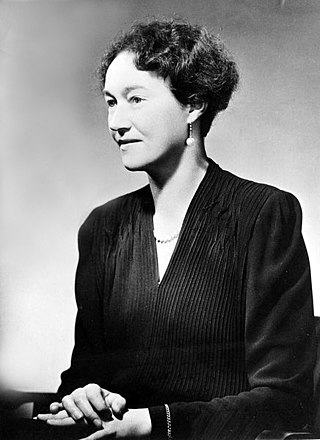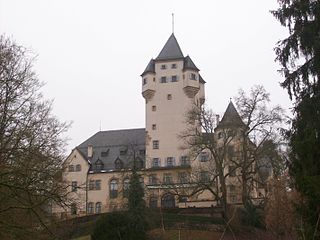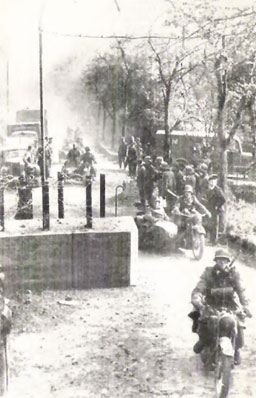
The Luxembourg Armed Forces are the national military force of Luxembourg. The army has been a fully volunteer military since 1967. As of December 2018, it has 939 personnel.
The Grand Ducal Family of Luxembourg constitutes the House of Luxembourg-Nassau, headed by the sovereign Grand Duke, and in which the throne of the grand duchy is hereditary. It consists of heirs and descendants of the House of Nassau-Weilburg, whose sovereign territories passed cognatically from the House of Nassau to the House of Bourbon-Parma, itself a branch of the Spanish Royal House which is agnatically a cadet branch of the House of Capet that originated in France, itself a derivative dynasty from the Robertians and the founding house of the Capetian dynasty.

Jean was the Grand Duke of Luxembourg from 1964 until his abdication in 2000. He was the first Grand Duke of Luxembourg of French agnatic descent.

Charlotte reigned as Grand Duchess of Luxembourg from 14 January 1919 until her abdication on 12 November 1964.

Prince Guillaume, Hereditary Grand Duke of Luxembourg, is the heir apparent to the crown of Luxembourg since his father's accession in 2000.

Prince Félix of Luxembourg is the second son of Henri, Grand Duke of Luxembourg, and Maria Teresa, Grand Duchess of Luxembourg. He is currently fourth in the line of succession.

Princess Alexandra of Luxembourg, Princess of Nassau and Princess of Bourbon-Parma is the fourth child and only daughter of Henri, Grand Duke of Luxembourg, and Maria Teresa, Grand Duchess of Luxembourg.

Prince Sébastien of Luxembourg is the fifth and youngest child of Henri, Grand Duke of Luxembourg, and Maria Teresa, Grand Duchess of Luxembourg.
Several palaces are named Ducal Palace because it was the seat or residence of a duke.

Berg Castle, also called Colmar-Berg, is the principal residence of the Grand Duke of Luxembourg. It is situated in the town of Colmar-Berg, in central Luxembourg, near the confluence of the Alzette and the Attert, two of Luxembourg's most important rivers.

The Grand Ducal Palace is a palace in Luxembourg City, in southern Luxembourg. It is the official residence of the grand duke of Luxembourg, and where he performs most of his duties as head of state of the Grand Duchy.

The Grand Ducal Police is the national police force of the Grand Duchy of Luxembourg. The police is under the control of the Minister for the Interior of Luxembourg, although they operate in the name, and under the ultimate control, of the Grand Duke of Luxembourg. Day-to-day executive control is exercised by the Director-General of the Grand Ducal Police. The Grand Ducal Police has existed in its current form since 1 January 2000, when the Grand Ducal Gendarmerie was merged with the police service.
The Grand Ducal Gendarmerie was the national Gendarmerie force of the Grand Duchy of Luxembourg, carrying both civil and military duties. It merged on January 1, 2000, with local police forces under state authority to form the Grand Ducal Police, the country's current national police force.

The Luxembourg Military Band, known locally as the Musique militaire grand-ducale, was founded in 1842 and has been a major contributor to Luxembourg's musical heritage. In addition to official performances for the Grand-Duke, the national government and the Luxembourg Army, the band frequently gives concerts in and around Luxembourg City.

Princess Stéphanie, Hereditary Grand Duchess of Luxembourg, is the wife of Hereditary Grand Duke Guillaume, the heir apparent to the throne of Luxembourg. She became engaged to the Hereditary Grand Duke on 26 April 2012 and married him, in a civil ceremony, on 19 October 2012, followed by a religious service the next day. The couple have two sons, Prince Charles and Prince François.

The German invasion of Luxembourg was part of Case Yellow, the German invasion of the Low Countries—Belgium, Luxembourg and the Netherlands—and France during World War II. The battle began on 10 May 1940 and lasted just one day. Facing only light resistance, German troops quickly occupied Luxembourg. The Luxembourgish government, and Grand Duchess Charlotte, managed to escape the country and a government-in-exile was created in London.

Émile Speller was a Luxembourgish military officer and the commander of the country's Gendarmes and Volunteers Corps during the German invasion of Luxembourg in World War II. He also served as aide-de-camp to several members of the Grand Ducal Family throughout his career and chamberlain of the Grand Ducal court.

Prince Charles of Luxembourg is the elder child of Hereditary Grand Duke Guillaume and Hereditary Grand Duchess Stéphanie. He was born at Grand Duchess Charlotte Maternity Hospital in Luxembourg City. He is second in the line of succession to the throne of Luxembourg. His birth was celebrated by a 21-gun salute at Fort Thungen in Kirchberg.
Princess Marie-Gabrielle of Luxembourg was a Luxembourgish princess, the third daughter and fourth child of Grand Duchess Charlotte (1896–1985) and Prince Felix of Bourbon-Parma (1893–1970).













